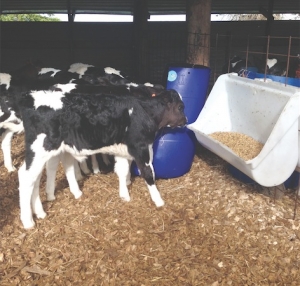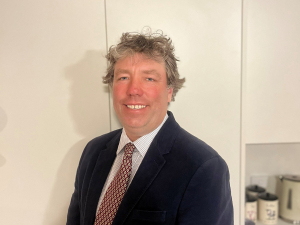The Flemings’ Gorae West farm in south-west Victoria already had a low sickness and death rate but Jess wanted to strive for even better results.
With husband Geoff and his parents Peter and Gloria Thomas, Jess called on Gemma Chuck from The Vet Group, western Victoria, to tighten their routine and introduce an accelerated calf rearing program.
The changes included a stronger cleaning and hygiene protocol, new flooring in the shed, vents in the back walls and plans to add whirly gigs in the roof for increased ventilation and more natural light.
There has been particular focus on feeding and although the program was introduced only this calving season, the benefits are already clear.
“The calves are big and strong,” Jess says. “We’ve got one-month-old calves that look like they’re two months’ old. They drink their feed and then it’s straight into the hay. We’re topping up the hay and grain at a record rate which is brilliant because they are developing this lovely healthy rumen which is what we want.”
Overall calf health is better and the Flemings expect to see more improvements as further changes are implemented.
“We weren’t financially able to build a new calf shed and do a complete change; we had to work within our financial restraints and make small changes. We were doing things the right way but just not 100%,” she says.
The changes were designed to improve calf health and growth, introduce labour efficiencies and reduce the weaning time. “The average weaning age was about 16 weeks, based on weight. We had calves still in the shed when we had the next lot calving. It was getting messy and drawing out,” Jess says.
“We had heifers on milk for a long time and were weaning at big weights, 120-160 kgs. We were looking for ways to tighten that up and to reduce the time we spent lugging buckets,” Jess says.
The accelerated calf rearing program of putting powder into whole milk is labour intensive but having good results.
They are also using Perfect Udder colostrum storage bags imported from America and they test the colostrum with a refractor meter to ensure it is top quality.
“With the nozzle at the top, all you have to do is connect the tube feeder and feed directly from the bag, preventing cross contamination and handling. It’s reducing the risks.”
Jess is a strong advocate of refractor meters – even going as far as buying two as birthday presents for friends and family. “If I can encourage better colostrum management and healthy calves not only on my farm but others, that’s great,” she says.
“It is very affordable and takes about 20 seconds to test colostrum to know that it’s good. People say it looks like good colostrum but you can’t tell by looking at it.
“Geoff and I make a game out of it - we have a go at judging it ourselves before getting the scientific data from the refractor meter.”
“All anecdotal claims are out the window when you have the results in front of you.”
Apart from one calf with a random e-coli disease that survived and is healthy, the only illness this season was identified in three calves that accidentally didn’t receive their colostrum.
“There are 50 calves in the shed and the only ones that got sick didn’t get colostrum – that’s good enough for me,” Jess says.
Jess describes good colostrum feeding as “calf care 101”.
“A lot of people think they don’t have the time but studies show heifers that receive adequate amounts of colostrum grow better and we all know the old adage that big heifers excel…50kg extra weight at calving is 800 litres more milk over a lactation. It all ties in.”
The farm has adopted a new cleaning and hygiene protocol and used a mini digger to remove the previous floor and install a new bed of scoria, shade-cloth and woodchips, along with vents in the back wall.
“Straight away the calves seem to be happier,” Jess says.
“Calves are born with no immune systems and giving your feeders a good scrub once a week isn’t enough. You wouldn’t feed your baby out of a bottle that was only cleaned once a week. They are valuable and you have to look at them like little babies and be very spot-on in sterilising and being clean and doing what you can, especially with the value of them at the moment.
“At the end of the day we’re doing this because we want big happy healthy heifers that are going to milk well, get back in calf and put milk in the vat. That’s what every farmer wants.”
















